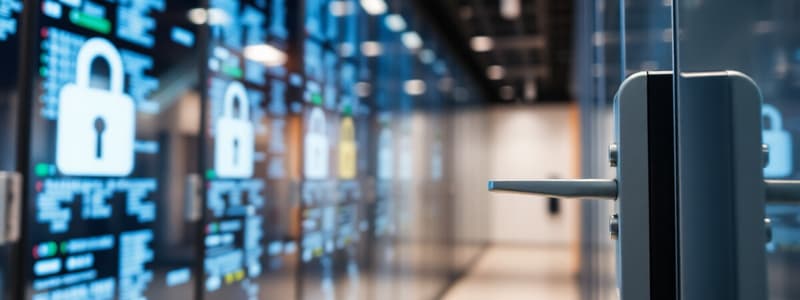Podcast
Questions and Answers
What is the primary purpose of an Access Control List (ACL) in access control systems?
What is the primary purpose of an Access Control List (ACL) in access control systems?
- To log all unauthorized access attempts
- To authenticate users before access is granted
- To define permissions granted to specific subjects for resources (correct)
- To create backup copies of resources
Which of the following processes is NOT part of the access control system?
Which of the following processes is NOT part of the access control system?
- Compilation (correct)
- Identification
- Authentication
- Authorization
What does the principle of 'least privilege' advocate for in access control?
What does the principle of 'least privilege' advocate for in access control?
- Granting maximum permissions to all users
- Automatically granting all sources access by default
- Creating unnecessary complexity in permissions management
- Providing only the necessary permissions for users to perform their job functions (correct)
In the context of access control, what does 'implicit deny' mean?
In the context of access control, what does 'implicit deny' mean?
Which access control model emphasizes the owner's rights over resource permissions?
Which access control model emphasizes the owner's rights over resource permissions?
What is the primary role of Mandatory Access Control (MAC) in an access control system?
What is the primary role of Mandatory Access Control (MAC) in an access control system?
Which of the following is NOT a characteristic of Role-based Access Control (RBAC)?
Which of the following is NOT a characteristic of Role-based Access Control (RBAC)?
How does continuous authentication enhance security in access control systems?
How does continuous authentication enhance security in access control systems?
Which of the following best describes the purpose of accounting in an access control system?
Which of the following best describes the purpose of accounting in an access control system?
What is the most appropriate use of a Standard User account in Windows?
What is the most appropriate use of a Standard User account in Windows?
What is a significant disadvantage of Single Sign-On (SSO)?
What is a significant disadvantage of Single Sign-On (SSO)?
Which method is NOT a type of encryption mentioned in the content?
Which method is NOT a type of encryption mentioned in the content?
What is the main challenge associated with symmetric encryption?
What is the main challenge associated with symmetric encryption?
How does asymmetric encryption primarily enhance security during communication?
How does asymmetric encryption primarily enhance security during communication?
Which type of encryption is described as being faster but less complex than asymmetric encryption?
Which type of encryption is described as being faster but less complex than asymmetric encryption?
What is the role of a Certificate Authority (CA) in Public Key Infrastructure (PKI)?
What is the role of a Certificate Authority (CA) in Public Key Infrastructure (PKI)?
What primary benefit does using encryption provide for information traveling over public networks?
What primary benefit does using encryption provide for information traveling over public networks?
Which authentication factor is most susceptible to loss and theft?
Which authentication factor is most susceptible to loss and theft?
What is a primary drawback of using biometric authentication?
What is a primary drawback of using biometric authentication?
Why is multifactor authentication considered stronger than single-factor authentication?
Why is multifactor authentication considered stronger than single-factor authentication?
Which method is NOT typically classified as an authentication factor?
Which method is NOT typically classified as an authentication factor?
What is a potential drawback of location-based authentication?
What is a potential drawback of location-based authentication?
What type of data is primarily used in personally identifiable information (PII) for authentication?
What type of data is primarily used in personally identifiable information (PII) for authentication?
Which authentication method combines a hardware token with a PIN code?
Which authentication method combines a hardware token with a PIN code?
Which of the following is a feature of Windows Hello?
Which of the following is a feature of Windows Hello?
Flashcards
Access Control System
Access Control System
A set of controls determining how subjects (users, processes) interact with objects (resources, like files, networks).
Access Control List (ACL)
Access Control List (ACL)
A list of subjects and their permissions on an object. It's the core of most access control systems.
Least Privilege
Least Privilege
Granting users only the rights they need to perform their job, minimizing risk.
Implicit Deny
Implicit Deny
Signup and view all the flashcards
Discretionary Access Control (DAC)
Discretionary Access Control (DAC)
Signup and view all the flashcards
RBAC (Role-Based Access Control)
RBAC (Role-Based Access Control)
Signup and view all the flashcards
MAC (Mandatory Access Control)
MAC (Mandatory Access Control)
Signup and view all the flashcards
User Account Types
User Account Types
Signup and view all the flashcards
Non-repudiation
Non-repudiation
Signup and view all the flashcards
Group Accounts
Group Accounts
Signup and view all the flashcards
Multifactor Authentication
Multifactor Authentication
Signup and view all the flashcards
Single Sign-On (SSO)
Single Sign-On (SSO)
Signup and view all the flashcards
Symmetric Encryption
Symmetric Encryption
Signup and view all the flashcards
Asymmetric Encryption
Asymmetric Encryption
Signup and view all the flashcards
Public Key Infrastructure (PKI)
Public Key Infrastructure (PKI)
Signup and view all the flashcards
Cipher Text
Cipher Text
Signup and view all the flashcards
Plain Text
Plain Text
Signup and view all the flashcards
Authentication Factors
Authentication Factors
Signup and view all the flashcards
Something You Know
Something You Know
Signup and view all the flashcards
Something You Have
Something You Have
Signup and view all the flashcards
Something You Are
Something You Are
Signup and view all the flashcards
Multifactor Authentication
Multifactor Authentication
Signup and view all the flashcards
Two-Factor Authentication
Two-Factor Authentication
Signup and view all the flashcards
Smart Card
Smart Card
Signup and view all the flashcards
Windows Hello
Windows Hello
Signup and view all the flashcards
Study Notes
Access Control Systems
- Access control systems manage subject-object interactions. Subjects are users, processes, or anything needing access. Objects are resources like networks, servers, and files.
- Access Control Lists (ACLs) detail subjects and their permissions on objects.
- Access control systems involve four key processes:
- Identification: Creating user or process IDs.
- Authentication: Verifying subject identity.
- Authorization: Defining and enforcing subject permissions on resources.
- Accounting: Tracking resource usage.
Least Privilege and Implicit Deny
- Least privilege limits permissions to only what users need for job functions, reducing misuse risk.
- Implicit deny relies on explicit authorization for access, denying any request not explicitly permitted. This model is common in firewall rules.
Authorization Access Models
- Discretionary Access Control (DAC): Resource owners control access, granting permissions to others.
- Role-Based Access Control (RBAC): Uses predefined roles and assigns users to those roles to manage access efficiently.
- Mandatory Access Control (MAC): Uses security clearance levels (labels) for restricted access based on hierarchical trust. A user can only access objects at their clearance level or below.
- Rule-based Access Control: Policies based on system-enforced rules, such as RBAC and MAC, are examples. Continuous authentication (e.g., Windows UAC) adds an extra layer of security by requiring confirmation for privileged actions.
Accounting and Non-repudiation
- Accounting logs user authentication and access, providing an audit trail for authorized and unauthorized actions.
- Logging is part of enforcing non-repudiation (the user cannot deny actions).
- Non-repudiation is established through various mechanisms:
- Video surveillance
- Biometrics (strong authentication)
- Signatures
- Receipts
User Account Types
- User accounts validate user identity during login.
- Default Windows user accounts:
- Administrator: Full control, disabled by default, strong password required.
- Guest: Disabled by default.
- User Accounts created during setup: Local or Microsoft account, Admin privileges by default.
Group Accounts
- Group accounts simplify administration, assigning permissions to groups and enabling inheritance to users.
- Windows default groups:
- Administrators: Full control, used sparingly.
- Standard Users: Basic functions, restricted admin privileges.
- Workgroups have limited group accounts.
Authentication Factors
- Authentication ensures accounts are used only by their proper holders.
- Authentication factors:
- Something you know (passwords, PINs, etc.)
- Something you have (smart cards, tokens)
- Something you are (biometrics)
Password Cracking and Management
- "Something you know" authentication is prone to password attacks.
- Cracking methods:
- Dictionary attacks (using common words)
- Brute-force attacks (trying all possible combinations)
- Password best practices:
- Length (longer is better)
- Complexity (avoid simple words, blend upper/lowercase)
- Memorability (use long phrases with symbols)
- Confidentiality (don't share or write down)
- History and expiration (change regularly)
- Avoid reuse (don't use passwords across sites)
Encryption Types
- Encryption hides information using keys.
- Common terminology:
- Plain text: Unencrypted data
- Cipher text: Encrypted data
- Cipher: Encryption/decryption algorithm
- Encryption types:
- Symmetric (single key for encryption and decryption); security depends on keeping the key secret.
- Asymmetric (public and private keys); suitable for authentication and key exchange.
- Cryptographic hashing (creates short, fixed-length data representations for integrity checks)
Public Key Infrastructure (PKI)
- PKI authenticates subjects on public networks using digital certificates (a public key embedded and signed by a Certificate Authority).
- Clients encrypt data using a server's public key for secure transmission.
Digital Signatures
- Digital signatures use private keys to encrypt messages, proving their origin and preventing modification.
Virtual Private Networks (VPNs)
- A VPN creates a secure tunnel through a public network to connect two private networks or a remote host to a local network, employing encryption and authentication.
Studying That Suits You
Use AI to generate personalized quizzes and flashcards to suit your learning preferences.




